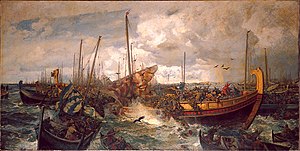
Back معركة سفولدر Arabic Batalla de Svolder AST Сволдерска битка Bulgarian Batalla de Svolder Catalan Bitva u Svolderu Czech Slaget ved Svold Danish Seeschlacht von Svold German Batalla de Svolder Spanish Svolderi merelahing Estonian نبرد اسفوادر Persian
| Battle of Svolder | |||||||
|---|---|---|---|---|---|---|---|
 The Battle of Svolder, by Otto Sinding | |||||||
| |||||||
| Belligerents | |||||||
|
|
Sweden Jarls of Lade | ||||||
| Commanders and leaders | |||||||
|
|
Olaf the Swede Svein Forkbeard | ||||||
| Strength | |||||||
| 11 warships | 70+ warships | ||||||
| Casualties and losses | |||||||
| Heavy, all ships captured | Reportedly heavy | ||||||
| There are no detailed contemporary sources. Information such as the number of ships cannot be regarded as reliable history. | |||||||
The Battle of Svolder (Svold or Swold)[2] was a large naval battle during the Viking age, fought in September 999 or 1000 in the western Baltic Sea between King Olaf of Norway and an alliance of the Kings of Denmark and Sweden and Olaf's enemies in Norway. The backdrop of the battle was the unification of Norway into a single independent state after longstanding Danish efforts to control the country, combined with the spread of Christianity in Scandinavia.
King Olaf Tryggvason was sailing to, or home from, an expedition in Wendland (Pomerania), when he was ambushed by an alliance of Svein Forkbeard, King of Denmark, Olof Skötkonung (also known as Olaf Eiríksson or Olaf the Swede), King of Sweden, and Eirik Hákonarson, Jarl of Lade. According to the Saga of King Olaf I Tryggvason, he had 60 warships plus the contribution of 11 warships from the Jomvikings [1] [3] His ships were captured one by one, last of all the Ormen Lange, which Jarl Eirik captured as Olaf threw himself into the sea. After the battle, Norway was ruled by the Jarls of Lade allied (as a suzerain) to both the Danish Crown and the Commonwealth of Uppsala, Sweden.
The exact location of the battle is disputed, and depends on which group of sources is preferred: Adam of Bremen places it in Øresund, while Icelandic sources place the battle near an island called Svolder, which is otherwise unknown.
The most detailed sources on the battle, the kings' sagas, were written approximately two centuries after it took place. Historically unreliable, they offer an extended literary account describing the battle and the events leading up to it in vivid detail. The sagas ascribe the causes of the battle to Olaf Tryggvason's ill-fated marriage proposal to Sigrid the Haughty and his problematic marriage to Thyri, sister of Svein Forkbeard. As the battle starts Olaf is shown dismissing the Danish and Swedish fleets with ethnic insults and bravado while admitting that Eirik Hákonarson and his men are dangerous because "they are Norwegians like us". The best known episode in the battle is the breaking of Einarr Þambarskelfir's bow, which heralds Olaf's defeat.
In later centuries, the saga descriptions of the battle, especially that in Snorri Sturluson's Heimskringla, have inspired a number of ballads and other works of literature.
© MMXXIII Rich X Search. We shall prevail. All rights reserved. Rich X Search